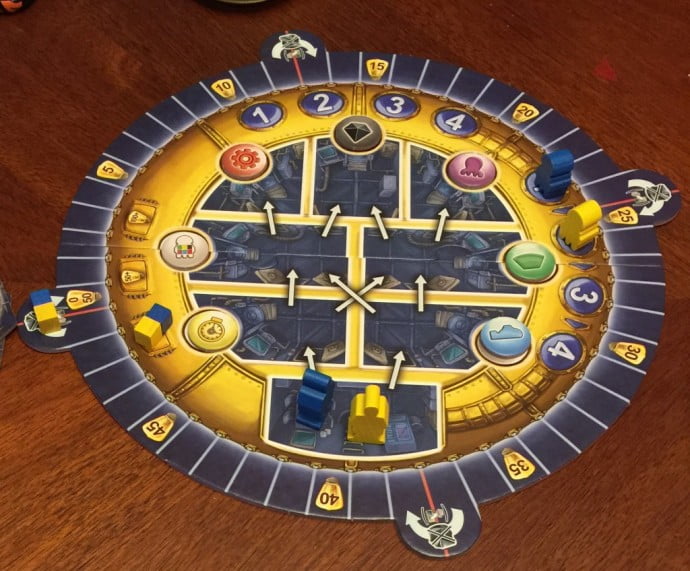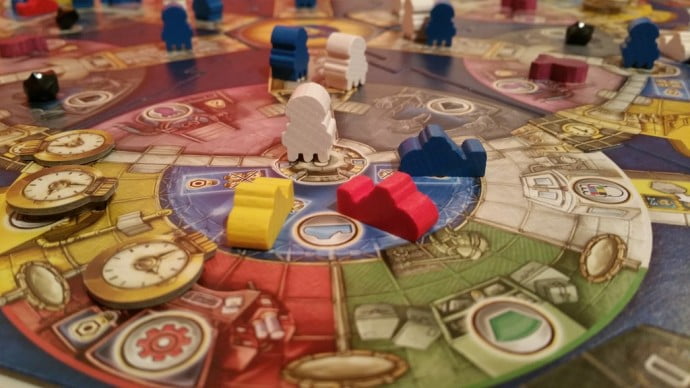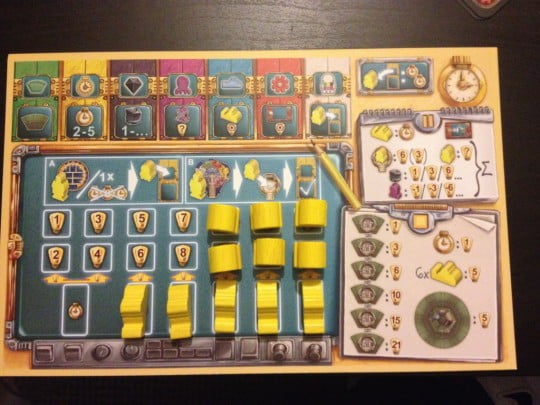Publisher: Tasty Minstrel Games
Review Copy Provided By: Tasty Minstrel Games
Release Date: October 2014
There’s a certain Saturday Morning Cartoon feel to AquaSphere. It’s wildly colorful and incredibly imaginative, and while it has it’s fair share of bumps along the way, the amount of fun derided from it is undeniable. No, AquaSphere isn’t perfect, or really anywhere near. But it’s a damned good time.
AquaSphere, Kickstarted to the tune of over $70,000, puts players in control of a research vessel at the bottom of the ocean. Your research comes in two parts: an engineer who programs robots to do your bidding, and a scientist who deploys them. The goal is collect the most Knowledge Points (KP) before the end of the 4 rounds and final scoring. This description is a gross simplification of the way the game plays, but the basic principle is simple.

Where the game becomes complicated is in it’s scoring. Each robot is programmable into one of six different categories, each serving a very different, but important, function. These functions might be more valuable at any time depending on the player’s position. By using a robot, you take control of one of the six sectors. See, there are two boards involved in AquaSphere, and each turn allows you to interact with just one of them. Your scientist, as mentioned before, deploys the bots and travels about the sectors, whilst your engineer is relegated to the other board, programming said bots. When you run out of options in a round, you’re forced to pass your turn, and thus take the next available turn for the next round.
Then intermediate scoring takes place… Oh, and I haven’t even gotten into the functions of what all of the bots are capable of!
Herein lies AquaSphere’s achilles heel. It’s a ton of fun to play once you’ve worked out the entirety of the game’s rulebook (and the rulebook is a doozy), but getting to that point can be exhausting and frustrating. Upon my first play, I easily spent upwards of 90 minutes trying to fully grasp the complexities of the rules, mainly the scoring and benefits of each of the robot abilities. Yes, everything is laid out in an orderly fashion in the game’s rule book, but the rules themselves are incredibly complex to comprehend for someone completely in the dark about the game.

Once you finally are able to get your game going, AquaSphere is an absolute blast, and the strategies required to win changed significantly as you increased the number of players. AquaSphere supports 2 to 4 players, but the game board grows progressively crowded as more people join. It seems to work best with just two players. There are only six sectors, and with three or four players all trying to get as many bots on the board as possible, taking cards, lab additions, and crystals (these are what you program your bot to do), too much is going on to keep track of everyone’s position.
The game grows much more cut throat as you add more players. In two player games, it’s easy to mind your own business until the final turn or so of each round. However with three and four players, each player has to be aware of the location of each player’s bots and scientist, as well as the types of cards and lab additions available. Not doing so will lead to your downfall. A game of two players requires a different stratagem than three or four players, and in some ways feels like entirely different game. Preference will tell you how many players is ideal for you (I prefer 2 players).

Every piece of the board feels significant, not only in their physical make-up – it’s a well-crafted game – but in each part’s role in a game. One might think that gathering as many crystals as possible is a sure-fire way to win, or they’ll think building the biggest lab is the secret sauce, but in reality, no individual piece is more important than the others. AquaSphere is thus a masterfully balanced experience, one that encourages a change in strategy from game-to-game. An early lead doesn’t always result in a victory, so, depending on your opponent, it might be a more intelligent decision to bide your time and gather resources for a blitzkrieg attack towards the middle or end of the game.
Review Overview
Score:
4/5
AquaSphere is a game that will remain a permanent staple of mine for a two-player experience, especially now that I’ve fully grasped the rules and strategies (though I’m sure I’ll discover even more as time goes on). For some, it’s a game that’ll bring feelings of nostalgia for old cartoons, for others it’ll look and feel like an old-school game, with new-school sensibilities.